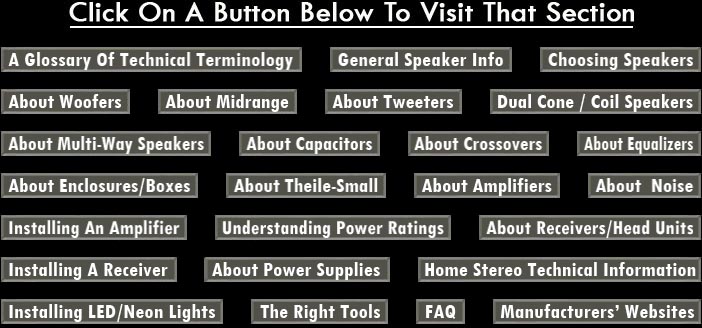


Back Plate
The part of the woofers metal Basket or frame on which the Magnet structure is mounted.
Back Light
In receivers, a display may be lit from the rear to create better visibility under a wide range of ambient light conditions.
Baffle
A flat panel that divides the front and rear sound waves produced by a woofer. Sometimes baffle is used to mean an enclosure or the front panel on which the speaker is mounted .
Balanced wiring
Audio line signals require two conductors. In an unbalanced line, the shield is one of those. In a balanced line, there are two internal wires plus the shield. For the system to be balanced requires output transformers and usually employs XLR connectors. Balanced lines are less apt to pick up external noise. This is usually not a factor in home or car audio, but is a factor in professional audio requiring hundreds or even thousands of feet of cabling.
Bandpass (box or enclosure)
An enclosure that is specifically tuned to give maximum energy to a very limited range of frequencies, usually the lowest. In this arrangement, the woofers are fully enclosed in the box with the sound pressure being vented through one or more ports.
Banana Jacks & Plugs
A set of connectors in which 4 spring contacts are wrapped vertically around a central pin like a banana peel. When inserted into the receptacle jack it maintains a strong and consistent contact. This type of connector is highly regarded as an excellent and reliable interconnector for cables between amplifiers and speakers.
Band-limiting filters
A low-pass and a high-pass filter in series, acting together to restrict (limit) the overall bandwidth of a system. Many audio amplifiers and processors, having switches labeled as "Rumble" or "Hiss," are filters of this type.
Bandpass filter
A filter that has a finite passband, neither of the cutoff frequencies being zero or infinite. The bandpass frequencies are normally associated with frequencies that define the half power points, i.e. the -3 dB points. In multi-driver speaker systems, the Midrange driver may be fed by a bandpass filter.
Bandpass Gain
The increase (or decrease) in efficiency of loudspeakers, due to the enclosure size and tuning. This is measured by the midband sensitivity of the speaker as a whole.
Bandwidth
Abbr. BW The numerical difference between the upper and lower -3 dB points of a band of audio frequencies. Used to figure the Q, or quality factor, for a filter.
Barium Ferrite
A speaker magnet material made from an alloy with iron and barium for improved magnetic strength.
Basket
The metal frame structure of a standard dynamic loudspeaker. In larger, heavier speakers, this may be made of cast metal for extra strength and rigidity. All the other elements of the speaker are mounted on this structure.
Bass
The portion of the audible sound spectrum that contains the lowest frequencies. These frequencies have the longest wavelength and require considerably greater electrical power to render them at their original strength. In a good modern speaker system, the bass portion of the response curve extends from as high as 500 hertz, down to 20 Hz.
Bass Boost/Enhancer Circuit
An active low pass amplifier section added to some receivers, equalizers, and amplifiers that allows as much as an 18 decibel boost to be applied to an audio signal in the low frequency 35 to 90 Hertz range.
Bass Reflex (box or enclosure)
A speaker box design that makes use of a port or Passive Radiator which allows the energy derived from the motion of the back of speaker cone to be redirected in such a way as to reinforce the front radiation. This smooths and extends the low frequency response, but the effect is sharply Rolled Off on the low end, as the port signal goes back out of phase with the front. The overall effect of this is to tune the bass response to a particular point on the lower end of the spectrum, below which it rolls off sharply.
BBE 1 & 2 Processing
A signal processing circuit that provides improvements in imaging and spatial realism by altering the frequency and phase characteristics of portions of the input signal.
Bel
Abbr. b, B Ten decibels. ( In honor of Alexander Graham Bell.) The Bel was originally a unit measure of the amount a signal dropped in level over a one-mile distance of telephone wire. See: decibel
Bessel Alignment
A particular crossover configuration which offers superior phase coherence in exchange for slightly lower output level match.Bessel: A design that places emphasis on phase and transient response over reducing ripple.
Bi-Amplification
Some speaker systems with multiple drivers do not contain a crossover network, and they require a separate amplifier for each frequency range. The bi-amplified system still requires an active crossover network to send the proper frequency band to each amplifier and speaker, but it is in the circuit preceding the amplifier and speaker and does not handle the power output.
Bipolar Transistor
A older but still effectively used transistor type that contains two p or n junctions or diodes between two layers of opposite polarity material (emitter and collector) . In handling large power, mostly replaced by MOSFET types.
BL
(measured in Tesla meters) The product of a speaker driveras gap flux density and the length of the voice coil conductor in the gap.
Blank Skip
A cassette feature that automatically detects blank areas of the tape over a set number of seconds in length and activates Fast Forward, until either the end of the tape, or audio information is reached.
BNC
A type of high precision connection often used in instrumentation and sometimes in digital audio. BNC connectors sometimes are used for digital connections such as from a CD Transport to the input of a DAC.
Boomy
Usually refers to excessivly reverberant bass response, or a peak in the bass response of a recording, playback, or sound reinforcement system.
Box
Another, and common name for a standard speaker enclosure. There are many variations in type, which are basically compromises between size, power handling, cost, frequency response, and many other considerations.
Bridge Mounted (2 & 3-way speakers)
In combined 2 and 3-way speakers, which have woofers together with a Tweeter, or a Tweeter and a Midrange Driver, the smaller drivers are attached to the woofer by either one of two standard mountings.
The bridge-mount method has a metal or plastic bridge running from one side of the woofer's outer perimeter to the other. The smaller driver or drivers, together with the Crossover network, is then mounted on the bridge. The advantage of this arrangement is that the woofer is left intact with no exposure of the voice coil or other internal elements. On the negative side, there is more covered surface area that marginally reduces the output at certain frequencies, and makes it a little more difficult to mount the unit.
The post-mount method provides a post that is attached to the center of the inner magnetic pole, to which the other drivers are then mounted. It has a reduced obstruction to woofer dispersion, but it does require a hole in the Dust Cover/Cap that can give environmental access to the woofer's inner workings. This creates the possibility in some less well designed units of operational degradation from airborne particles over time.
Bridged Power
Bridging an amplifier, combines the power output of two channels into one channel. Bridging allows the amplifier to drive one speaker with more power than the amp could produce for two speakers. Because of this high power output, bridging is the best way to drive a single subwoofer.
If the amp is bridgeable, the owner's manual will have directions that tell you how. Usually, an amp is bridged by connecting the speaker leads to the positive (+) terminal from one channel and the negative (-) terminal from the other channel. However, be sure to consult your owner's manual before attempting to bridge your amp!
Also, keep in mind that most amplifiers need to see a 4-ohm load when bridged to mono operation. When bridging an amplifier, use one 4-ohm speaker or, if you prefer multiple woofers, connect two 8-ohm speakers in parallel. Again, consult your manual before operating your amp in bridged mode.
BTL
Bridged, Transformer Less. A circuit design wherein two small Integrated Circuit (IC) amplifier channels are bridged together to provide a single, larger output circuit. These circuits are limited by their current capabilities and the amount of heat they generate.
BTM
Best Tuning Memory. A feature in which the tuner selects radio stations by signal strength, and assigns them to presets in numerical order, according to their frequency value.
Built-in Crossovers
Frequently used to limit the high-frequencies reaching a subwoofer, a low-pass filter crossover allows only frequencies below the crossover point to be amplified. A high-pass crossover allows only frequencies above the crossover point to be amplified a used to keep destructive low bass away from small speakers, so they can played safely. Crossovers may be variable or selectable. Continuously Variable means the crossover circuit can be adjusted to any frequency between the listed end points. Selectable means that any of several preset crossover points can be chosen to accomodate variuous driver (speaker) designs.
Bumped
A method of woofer construction in which the rear suspension system is anchored a little further back by designing the back plate so that it is press stamped, or cast, outward. This allows greater Excursion of the voice coil, and prevents "bottoming out," which is very destructive to the coil form when large signals move the voice coil beyond its range limits. This technique does not eliminate the problem, but does help to reduce it.
Bumped & Vented
See discussion of Bumped above. Many higher power speakers have a vent hole in the center Pole Piece of the magnet. When viewed from the back, there is usually a screen over the hole to prevent debris or particles from falling into the voice coil gap. But it does allow for greater ventilation of the motor section, and this in turn provides for higher power inputs by permitting greater heat dissipation for the voice coil assembly.
Bullet Horn (tweeter)
A type of tweeter in which the radiator has a large passive, bullet-shaped device above its center that extends the nominal dispersion angle of the sound, thus allowing it to cover a greater area with high frequency radiation
Buss or Bus
A signal-carrying conductor or electrical pathway designed to carry multiple signals. A mixing console auxiliary bus may carry signals derived from several channels on that console. The term is sometimes used to refer to a power distribution circuit, or "mains".
Butyl
A type of rubber used for speaker surrounds. Butyl has very good damping characteristics and is resistant to UV contamination from the sun.
Butterworth crossover
A type of crossover circuit utilizing low-pass filter design characterized by having a maximally flat magnitude response, i.e., no variation in the amplitude response in the domain of the passband.















